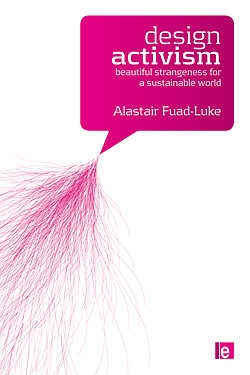"This book charts the territory of the design activist — a person who uses the power of design for the greater good of humankind and nature. [ ] Most of all, this book is for everyone who believes that design (especially when we design together) is an essential human expression that will help us all to move towards more sustainable futures", explains Alastair Fuad-Luke in the preface of his newly released book Design Activism, beautiful strangeness for a sustainable world. The author of the Eco-Design Handbook (2004) has yet again created a kind of bible for eco-designers. This book helps everyone to become a better (or good!) designer. In order to do so, one needs to understand where we come from, and what design activism stands for. (Chapter 1 & 2) Secondly, it is important to understand the current situation and the future, in order to design according to poverty, exploitation of the natural capital, reduction of biodiversity, and, to top things off, climate change. Fast changing situations, globally and locally, are key issues, so the designers need to see the bigger picture, which is very well explained in chapter three.
Design activism has already started, with many new organisations focusing on social design, slow design, architecture etc. So Fuad-Luke analyses this emerging design activism and the relationship between design practice, studies and explorations, as well as the role of artefacts like Virtual Water and Clean Tap Water by FLOWmarket. Here we can also read about what Fuad-Luke calls "halfway products", products where the user has to engage in order to finish the design process. An example he shows is An Affair with a Chair by Natalie Schaap. Under "meaningful production" we can find the Gardening Bench byJurgen Bey. The RD4Chair by Codha is analysed in "Experiments in bio- and techno-cyclicity". Chapter four basically features plenty of existing design projects, well illustrated and explained from the rather unusual viewpoint of activism.
The fifth chapter starts with the author's quote:
The purpose of (co-)design is the creation of new societal values to balance human happiness with ecological truths. In doing so design contests the notion of material and economic progress, and its inherent ecological untruths.
The co-design approach is something Fuad-Luke has been working on for a long time (see AFL web site), and chapter five explains how it's done. The principles of Slow Design are also dealt with here. Chapter six is about the people, the activists. It is about how to share, how to collaborate, how to plan co-events, how to visualise and how to make stuff. The last chapter goes into detail about how to design for a better future: bio-local and bio-regional, eco-efficiency, regeneration and renewal, and why we need MootSpaces, so that decisions on what, where and how to design are made in more democratically inspired ways.
Like Alastair Fuad-Luke himself explains, Design Activism "aims to be a comprehensive study of how design-led or design-inspired activism is able to engender positive socio-eco and cultural change, and to ask of the reader, 'How do you wish to use your design skills for positive change?'"
Design activism by Alastair Fuad-Luke
Beautiful strangeness for a sustainable world

The book content:
Preface
1. Scoping the Territory: Design, Activism and Sustainability
2. Past Lessons: A Short History of Design in Activist Mode, 1750 to 2000
3. Global-Local Tensions: Key Drivers for Design Activism in an Unsustainable World
4. Contemporary Expressions: Design Activism, 2000 Onwards
5. Designing Together: The Power of 'We Think', 'We Design', 'We Make'
6. Activist Frameworks & Tools: Nodes, Networks & Technology, Tools
7. Adaptive Capacity: Design as a Societal Strategy for Designing 'Now' and 'Co-futuring'
Appendices
Notes
Bibliography
Index
Design Activism was first published by Earthscan in the UK and USA in 2009.
ISBN (hardback, £85.00): 978-1-84407-644-4
ISBN (paperback, £24.95): 978-1-84407-645-1
Printed on FSC certified paper using soya-based inks, and like all Earthscan books, the CO2 emissions created through the publication of the books was offset. ::Earthscan/Design Activism ::Alastair Fuad-Luke